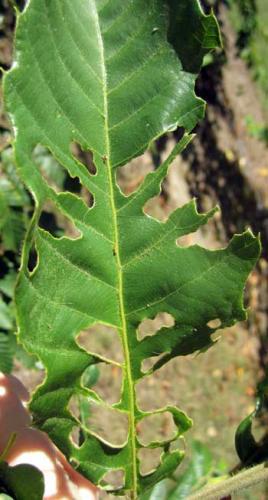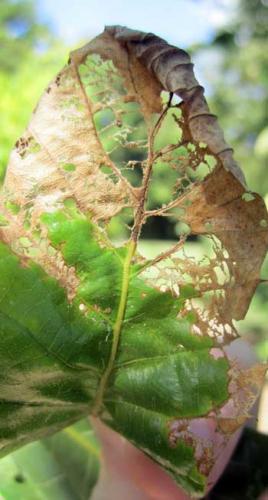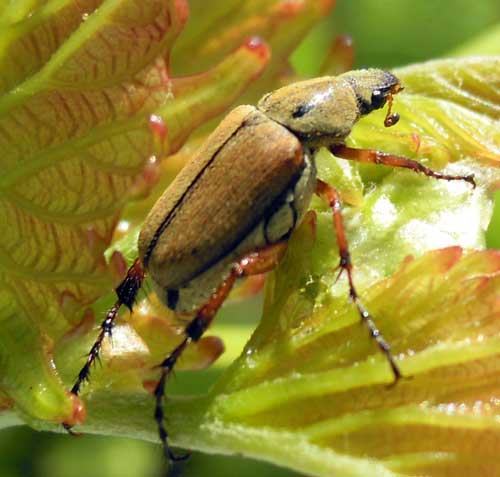Rose chafer management in chestnuts for 2013
The 2012 season saw high populations of rose chafers in Michigan chestnut orchards and growers will need to prepare to combat this important pest in the coming season.
Rose chafers are considered a generalist pest and affect many crops, particularly those found on or near sandy soils or grassy areas. The adult beetles feed heavily on foliage and blossom parts of numerous horticultural crops in Michigan and can cause significant damage to chestnut orchards. Rose chafers can be particularly damaging on young trees with limited leaf area. Like Japanese beetles, rose chafers skeletonize the chestnut leaves, but tend to consume larger pockets of tissue with damage similar to caterpillar feeding than the fine, lace-like leaf that results from Japanese beetle feeding (Photos 1 and 2).


Photo 1 (left). Typical rose chafer damage. Photo 2 (right). Typical Japanese beetle damage.
Photo credit: Erin Lizotte, MSUE
The rose chafer is a light tan beetle with a darker brown head and long legs and is about 12 mm long (Photo 3). There is one generation per year. Adults emerge from the ground during late May or June and live for three to four weeks. Females lay groups of eggs just below the surface in grassy areas of sandy, well-drained soils. The larvae (grubs) spend the winter underground, move up in the soil to feed on grass roots and then pupate in the spring. A few weeks later, they emerge from the soil and disperse by flight. Male beetles are attracted to females and congregate on plants to mate and feed.

Photo 3. Rose chafer adult. Photo credit: Erin Lizotte, MSUE
They are often found in mating pairs and fly during daylight hours. Visual observation while walking a transect is the best method for locating them. Because of their aggregating behavior, they tend to be found in larger groups and are typically relatively easy to spot. There are no established treatment thresholds or data on how much damage a healthy chestnut tree can sustain from rose chafers, but growers should consider that well-established and vigorous orchards will likely not require complete control. Younger orchards with limited leaf area will need to be managed more aggressively.
Managing rose chafers can be a frustrating endeavor as they can re-infest from surrounding areas quickly. This re-infestation is often misinterpreted as an insecticide failure, but efficacy trials have shown that a number of insecticides remain effective treatment options. Carbamate, organophosphate, pyrethroid and neonicotinoid insecticides all have good activity against rose chafers and can provide some control. Organic options including azadirachtin products and surround are marginally effective (Table 1). Growers choosing to use kaolin clay should remember that good coverage is key and those considering pyrethroids or neonicotinoids should be aware that these products may potentially increase pest mite populations.
Table 1. Insecticides with activity against rose chafers.
|
Chemical class (IRAC group) |
Active ingredient |
Products labeled |
|
Organophosphates (1B) |
Malathion |
Cheminova Malathion 57%, Malathion 57 EC, Malathion 8 Aquamal |
|
Phosmet |
Imidan 70W |
|
|
Carbamates(1A) |
Carbaryl |
Carbaryl 4L, Sevin 4F, Sevin 80 WSP, Sevin 80S, Sevin XLR Plus, Sevin SL |
|
Pyrethroids(3) |
Bifenthrin** |
Bifenture 10DF, Bifenture EC, Brigade WSB, Fanfare 2 EC, Sniper |
|
Beta-cyfluthrin** |
Baythroid XL |
|
|
Cyfluthrin** |
Renounce 20 WP, Tombstone, Tombstone Helios |
|
|
Gamma-cyhalothrin** |
Declare, Proaxis |
|
|
Lambdacyhalothrin** |
Grizzly Z, Kaiso 24WG, Lambda T, Lambda-CY EC, Lambdastar, Lambdastar 1CS, Lamcap, Nufarm Lambda-Cyhalothrin 1EC, Paradigm, Province, Silencer, Taiga Z, Warrior II with Zeon, Warrior with Zeon, Willowood Lambda-CY 1EC |
|
|
Pyrethrins* |
Pyganic EC 1.4 II, Pyganic EC 5.0 II |
|
|
Zeta-cypermethrin** |
Mustang, Mustang Max, Mustang Maxx, Respect, Respect EC |
|
|
Deltamethrin** |
Delta Gold |
|
|
Fenpropathrin** |
Danitol 2.4EC Spray |
|
|
Pyrethroid(3) + Pyrethroid(3) |
Bifenthrin** + Zeta-cypermethrin** |
Hero EW, Steed |
|
Pyrethroids(3) + Neonicitinoids(4A) |
Cyfluthrin** + Imidacloprid |
Leverage 2.7 |
|
Lambdacyhalothrin**; Thiamethoxam |
Endigo ZC |
|
|
Beta-cyfluthrin** + Imidacloprid |
Leverage 360 |
|
|
Bifenthrin** + Imidacloprid |
Brigadier, Swagger |
|
|
Neonicitinoids(4A) |
Imidacloprid |
Admire Flex 4, Admire Pro, Advise 2F, Amtide Imidacloprid 2F, Agri Star MACHO 2.0 FL, Agri Star MACHO 4.0, Couraze 2F, Couraze 4, Couraze 4F, Mana Alias 4F, Monatna 2F, Monatana 4F, Nuprid 1.6F, Nuprid 2F, Nuprid 2SC, Nuprid 4.6F Pro, Nuprid 4F Max, Pasada 1.6F, Pasada 75WSB, Provado 1.6F, Sherpa, Trimax Pro, Widow, Wrangler |
|
Thiamethoxam |
Flagship 25WG2 |
|
|
Acetamiprid |
Assail 30SG, Assail 70WP |
|
|
Clothianidin1 |
Belay |
|
|
Botanical insecticide |
Azadirachtin |
Aza-Direct*, Azatin XL, Ecozin Plus 1.2% ME*, Neemazad 1% EC*, Neemix 4.5*, Azaguard* |
|
Particle film |
Kaolin clay |
Surround* |
* OMRI approved for organic production.
** Products containing these active ingredients are classified as a restricted use pesticides and require the applicator to retain a pesticide applicator license.
1. Supplemental label subject to annual renewal.
2. For use on nonbearing trees only.
Interested in learning more about the resources available for current or future chestnut producers? Consider attending the upcoming Michigan State University Extension Integrated Pest Management Academy, Feb. 19-20, at the Okemos Conference Center in Okemos, Mich. It includes a half-day session with chestnut resources titled “Check it Out: MSU Resources for Hops, Saskatoons and Chestnuts.”
There are many other sessions to choose from in both the morning and the afternoon. Read more information on the sessions and how to register.
The cost of this event is $225 per person. Please note that snacks, lunch and parking are included. Lodging is not included, but special rates are available. Registration is open through Feb. 12, but space is limited so register today.
Related resources



 Print
Print Email
Email



